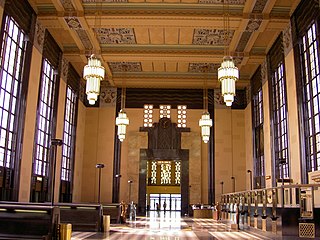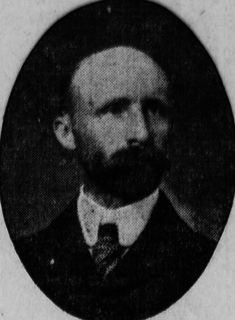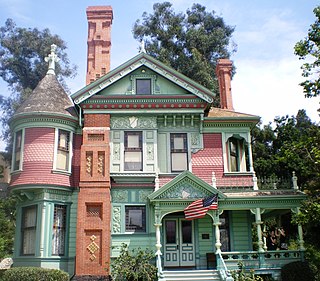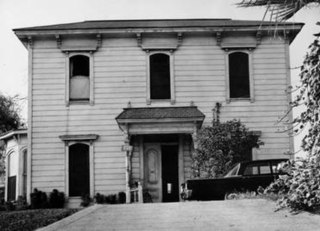
Richard Joseph Neutra was an Austrian-American architect. Living and building for the majority of his career in Southern California, he came to be considered among the most prominent and important modernist architects. He mainly built suburban single-family detached homes for wealthy clients. Among his most notable works is the Kaufmann Desert House in Palm Springs, California.

Gilbert Stanley Underwood (1890–1960) was an American architect best known for his National Park lodges. Born in 1890, Underwood received his B.A. from Yale in 1920 and a M.A. from Harvard in 1923. After opening an office in Los Angeles that year, he became associated with Daniel Ray Hull, a landscape architect, of the National Park Service. This led to a commission with the Utah Parks Company of the Union Pacific Railroad which was developing the parks in hopes of producing destinations for travelers. During this time Underwood designed lodges for Cedar Breaks National Monument, Zion National Park, Bryce Canyon National Park, and the North Rim of the Grand Canyon National Park. His surviving Utah Parks Company buildings are considered exceptional examples of the Rustic style of architecture, and are all listed on the National Register of Historic Places. In addition, Underwood was contracted to design Yosemite National Park's The Ahwahnee, also on the National Register and probably his greatest triumph in the Rustic style.

The Aline Barnsdall Hollyhock House in the East Hollywood neighborhood of Los Angeles, California, was designed by Frank Lloyd Wright originally as a residence for oil heiress Aline Barnsdall. The building is now the centerpiece of the city's Barnsdall Art Park. In July 2019, along with seven other buildings designed by Wright in the 20th century, it was added to the UNESCO World Heritage List. It is the first time modern American architecture has been recognized on the World Heritage List. The Hollyhock House is noted for developing an influential architectural aesthetic, which combined indoor and outdoor living spaces.

John and Donald Parkinson were a father-and-son architectural firm operating in the Los Angeles area in the early 20th century. They designed and built many of the city's iconic buildings, including Grand Central Market, the Memorial Coliseum and the City Hall.

Wagon Wheel is a densely populated, planned neighborhood of Oxnard, California at the intersection of U.S. Route 101 and Oxnard Boulevard. The neighborhood was originally developed as an office, motel, and restaurant complex named Wagon Wheel Junction with a convenient roadside location near the historic community of El Rio. The site in Ventura County became a popular stop for travelers between Los Angeles and Santa Barbara, particularly during its heyday in the 1950s, 1960s and 1970s. The entire site was demolished in 2011 to begin the development of the community with 1,500 residential units.

Heritage Square Museum is a living history and open-air architecture museum located beside the Arroyo Seco Parkway in the Montecito Heights neighborhood of Los Angeles, California, in the southern Arroyo Seco area. The living history museum shows the story of development in Southern California through historical architectural examples.

The Leonis Adobe, built in 1844, is one of the oldest surviving private residences in Los Angeles County and one of the oldest surviving buildings in the San Fernando Valley. Located in what is now Calabasas, California, the adobe was occupied by the wealthy rancher Miguel Leonis until his death. Following Leonis' death, the property was the subject of a legal dispute between his common law wife Espiritu Chijulla, heirs, and a daughter born out of wedlock; the dispute lasted more than 15 years in the courts. In 1961, the adobe had fallen victim to vandalism, and its owner applied for a permit to raze the structure and erect a supermarket in its place. Preservationists succeeded in having the adobe declared Los Angeles Historic-Cultural Monument #1 in 1962, saving it from the wrecking ball at the last minute. It was listed on the National Register of Historic Places in 1975.

Hale House is a Queen Anne style Victorian mansion built in 1887 in the Highland Park section of northeast Los Angeles, California. It has been described as "the most photographed house in the entire city", and "the most elaborately decorated". In 1966, it was declared a Historic-Cultural Monument, and in 1972 it was listed on the National Register of Historic Places. The house was relocated in 1970 to the Heritage Square Museum in Montecito Heights where it remains open to the public.

Chateau Colline is an historic eight-unit apartment building on Wilshire Boulevard in the Westwood section of Los Angeles, California.

The Neutra Office Building is a 4,800-square-foot (450 m2) office building in the Silver Lake section of Los Angeles, California. The building was owned and designed by Modernist architect Richard Neutra in 1950. It served as the studio and office for Neutra's architecture practice from 1950 until Neutra's death in 1970. The building has been declared a Historic Cultural Monument and listed on the National Register of Historic Places. It was listed for sale in 2007 at an asking price of $3,500,000.

Los Angeles Historic-Cultural Monuments are sites which have been designated by the Los Angeles, California, Cultural Heritage Commission as worthy of preservation based on architectural, historic and cultural criteria.

Victoria Park is a small neighborhood in the central region of Los Angeles, California. There are three Los Angeles Historic-Cultural Monuments located in Victoria Park.

The Salt Box was a house built in the 1880s in the Bunker Hill section of Los Angeles, California. Designed in the saltbox style that was popularized in New England, it was originally located at 339 South Bunker Hill Avenue. In the late 19th century, Bunker Hill was one of the most prestigious neighborhoods in Los Angeles and was the site of many elegant Victorian homes. The Los Angeles Times wrote of old Bunker Hill: "Nowhere else in Los Angeles was the architecture so ornate. The mansions were wooden-frame Victorian with Gothic gingerbread touches applied with a heavy hand to simulate masonry." Though not as elegant as many of its Victorian neighbors, the Salt Box was "cherished by architecture students for the simplicity of its design."
The USC School of Architecture (USCArchitecture) is the architecture school at the University of Southern California. Located in Los Angeles, California, it is one of the university's twenty-two professional schools, offering both undergraduate and graduate degrees in the fields of architecture, building science, landscape architecture and heritage conservation.
The Brentwood Country Mart is a local shopping center in the Brentwood district of Los Angeles, California, next to the Santa Monica eastern city limit. First opened on November 18, 1948, “it’s a quaint reminder of a bygone era, and Brentwood residents are very protective of it.”
Kurt Werner Meyer was a Swiss-born American architect active from 1948–1993. Working primarily in the Los Angeles area, Meyer is known for numerous financial institutions, educational building, civic buildings, and civic service.
Taix is a French restaurant in Los Angeles, California, founded in 1927. The restaurant complex features open and private dining rooms, banquet halls, and a cocktail lounge with live music called the 321 Lounge. The restaurant is currently located at 1911 Sunset Boulevard in the Echo Park neighborhood of Los Angeles.













